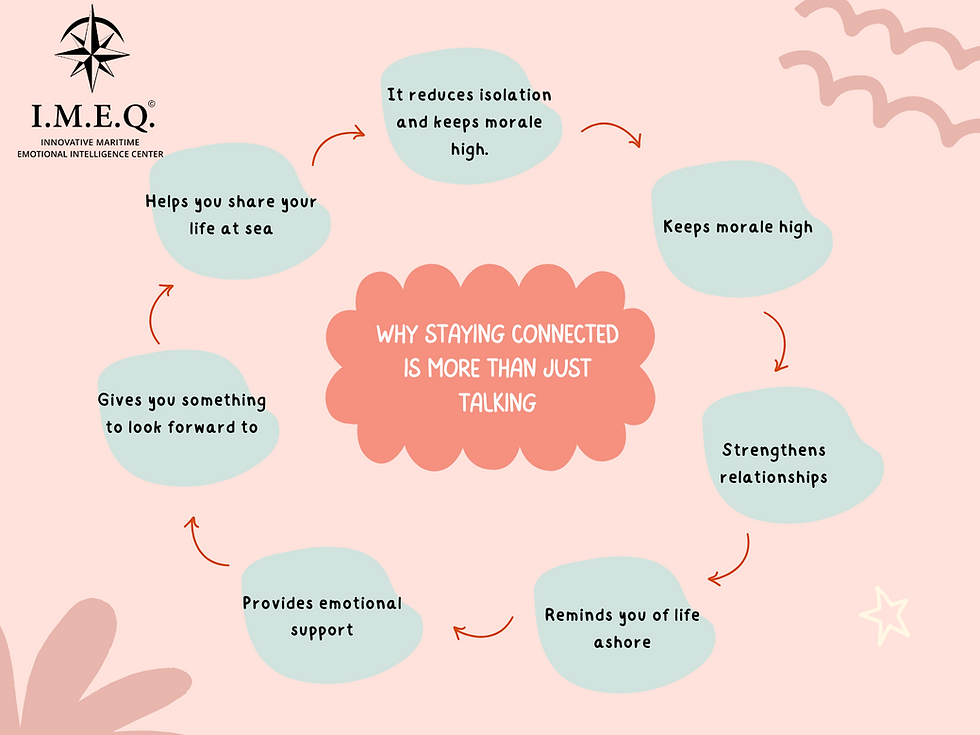How Seafarers Can Stay Emotionally Connected at Sea
- IMEQ CENTER

- Aug 22
- 3 min read
When you’re thousands of miles from shore, it’s not the horizon that feels far away—it’s the people you love.
You hear about birthdays you missed, family dinners without your chair at the table, friends getting together while you’re halfway across the world. You might be surrounded by the crew, but still feel a quiet kind of distance. This is the reality of life at sea: you’re always moving, yet the people you care about are in a different time zone, living a different daily rhythm.

In the past, letters and port calls were the only way to reach home. Today, Wi-Fi and messaging apps make things easier—but for many seafarers, connection still comes in small, expensive, or unreliable bursts. And yet, staying emotionally close isn’t about how much internet you have—it’s about how you use it.
Why Staying Connected Is More Than Just Talking
For seafarers, connection isn’t just a comfort—it’s a lifeline.
It reduces isolation and keeps morale high.
It reminds you there’s a life waiting for you ashore.
It strengthens relationships so that homecomings feel warm, not awkward.
The trick is finding ways to make those connections meaningful, even when time and data are short.
Onboard: Making Connection Part of Your Routine
1. Turn “Hello” Into a Ritual
Pick a set time for your messages or calls—maybe after your watch or before bed. Even if it’s just a 5-minute voice note, the consistency gives both you and your loved ones something to look forward to.
2. Use the Power of Voice
Texting is quick, but hearing someone’s voice brings emotion back into the conversation. Voice notes use little data and can be played when the other person is free—perfect for mismatched time zones.
3. Collect Moments, Share Later
When Wi-Fi is weak, take photos or short videos during the day—sunrises, the galley meal, a quick joke with your crewmate. When you connect, send them in a batch. It shows the people at home that you were thinking of them throughout your day.
4. Protect Your Connection Time
When you finally get internet, go to the people that matter before social media. The newsfeed can wait—real faces and real voices come first.
5. Build a “Message Bank”
Keep a small notebook or phone note where you jot down stories, thoughts, or memories you want to share. That way, when you do connect, the conversation flows instead of starting with “So… what’s new?”
Ashore: Deepening the Bond While You Can
Time off can fly by faster than any voyage. The key is to be intentional about how you spend it.
1. Make the First Days Sacred
Use your first few days home to recharge and focus on the people closest to you. Switch off work mode and step into life ashore fully.
2. Create Shared Memories
Do something together you can talk about during your next contract—a weekend trip, a family dinner, a special outing with your kids. Those shared moments become your conversation anchors at sea.
3. Talk About the Next Voyage Early
Let your family know when you’ll be leaving, what the schedule might look like, and how you plan to stay in touch. Setting expectations helps reduce the emotional drop-off later.
4. Share Your World
Bring a piece of the sea home—photos, small souvenirs, or stories. It helps your loved ones understand your life onboard and feel more connected to it.
When the Connection Isn’t Perfect
Even with planning, there will be moments when the signal is bad or the schedule doesn’t align. In those times:
Write letters or long messages to share later.
Lean on crew camaraderie—your shipmates often become your second family.
Remember that connection is built over time; missing a day or two won’t erase your bond.
Practical Low-Data Ideas for Seafarers
Use apps like WhatsApp or Signal for voice notes—they work well on weak connections.
Share photos in compressed form to save data.
Keep conversations short but frequent rather than long but rare.
Final Word
You can’t control the distance, the time zones, or the Wi-Fi speed. But you can control how intentional you are about staying emotionally present.
At sea, connection isn’t about constant contact—it’s about making every interaction count. A short voice note, a photo of today’s sunset, a simple “thinking of you” can bridge thousands of miles.
Because in the end, it’s not the signal bars that matter—it’s the heart behind the message.





































































































Comments